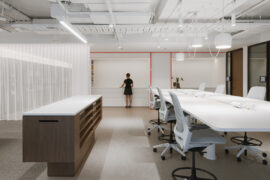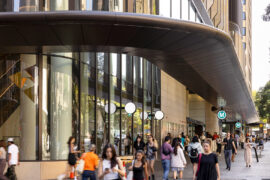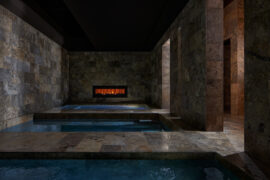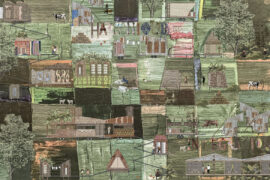The second of our three articles recapping the recent ‘Dense and Green Building Typologies’ symposium looks at the demand for green environments from real estate investors, tenants, and homebuyers.

Nicholas Mak, SLP Property Consultants
September 20th, 2017
How can greenery help to enhance income streams in commercial real estate? And how much thought do Singaporean homebuyers give to ‘green’ features in residential developments? The second segment of the symposium ‘Dense and Green Building Typologies: Architecture as an Urban Ecosystem’, held at The URA Centre on 30 August, offered something that’s not discussed enough: the perspective of clients and the real estate sector.
Dr Megan Waters, International Director and Head of Research at JLL Asia Pacific, began her presentation by suggesting buildings that enhance experience enjoy greater demand. While an enhanced experience may not increase the rent, it does minimise vacancies, which therefore benefits investors. It promotes the ‘stickiness’ effect that encourages tenants to stay for the long haul. The same can be said about workforce talent, she said. Greenery, of course, can play a key role in this.
Since the global financial crisis, there has been significantly more investment in commercial real estate, she said. Large pension funds are now investing more. It’s a good opportunity to enhance the environment of these buildings, she suggested. In the Asia Pacific region, she sees greenery in buildings as harbouring a huge untapped potential. In the coming years, APAC’s share of the global real estate market will increase from its current 30 per cent. International investors allocate by geography, said, Dr Waters, and therefore more money will flow into APAC.
Investors have some areas of concern with regards to greenery, however. Liability concerns surround rooftop gardens for example, and there is fear of the reputational damage should accidents occur.
She also spoke about the relationship between greenery and building refurbishment. Facade greening can provide a substantial upgrade to bleak-looking buildings, enhance the experience of them, and therefore increase rents. She sees Singapore’s Skyrise Greenery Incentive Scheme as something that Singapore can lead the region with, showing how government-led incentives can have excellent results (particularly with refurbishment).
Nicholas Mak, the Executive Director, CIO and Head of Research and Consultancy at SLP Property Consultants, presented the results of an insightful new study into the perceptions of Singaporean homebuyers of green building fabric. Do they believe the claims of developers, and is ‘green’ important in their investment decisions?
Some 15-20 years ago, he said, buyers and developers were chiefly focused on lifestyle and amenities. They still are, but now marketing collaterals for residential developments are much more focused on ‘green’ features.
The most popular ‘eco’ features are to do with saving energy and water within the home, and the green enhancement of areas outside the home. Having said that, buyers are disinclined to pay more for eco-friendly homes, even if savings on utility bills are possible; they consider eco-friendly homes to be the new standard. This expectation comes with serious doubts about the claims of marketing campaigns, however. Perhaps there are too many plastic plants in show flats!
Read about Government Perspectives of ‘dense and green’ here.
Stay tuned for our upcoming article on Architect/Landscape Perspectives from the symposium!
The symposium was organised by the ‘Dense and Green Building Typologies’ research group at the Future Cities Laboratory at the Singapore-ETH Centre. The group is led by Prof Dr Thomas Schroepfer from SUTD and Prof Dr Sacha Menz from ETH Zurich.
INDESIGN is on instagram
Follow @indesignlive
A searchable and comprehensive guide for specifying leading products and their suppliers
Keep up to date with the latest and greatest from our industry BFF's!

For Aidan Mawhinney, the secret ingredient to Living Edge’s success “comes down to people, product and place.” As the brand celebrates a significant 25-year milestone, it’s that commitment to authentic, sustainable design – and the people behind it all – that continues to anchor its legacy.

London-based design duo Raw Edges have joined forces with Established & Sons and Tongue & Groove to introduce Wall to Wall – a hand-stained, “living collection” that transforms parquet flooring into a canvas of colour, pattern, and possibility.

GEYER VALMONT is launching an innovation hub designed to improve existing interior design capability through enhanced ways of working and industry-leading technology products.

From Valmont to GEYER VALMONT, Marcel Zalloua walks us through some of the milestones of what has been a fruitful, busy career in design.
The internet never sleeps! Here's the stuff you might have missed

‘Civic Vision | Foster + Partners’ is the first comprehensive exhibition of the practice’s work to be held in Australia, providing an in-depth look at its global portfolio of work since it was founded in 1967 by Norman Foster.

The final day of CPD Live’s 2025 season delivers three must-attend sessions exploring circular design for furniture and fitouts, and the science behind safe, high-quality drinking water. Starting from 9 AM AEDT, 16th October – it’s your last opportunity this year to join our Live CPD sessions and finish 2025 inspired.

Hogg & Lamb’s Albion Bathhouse has been awarded The Health & Wellbeing Space at the INDE.Awards 2025. The project reimagines the contemporary bathhouse as an immersive architectural journey – one that restores balance through atmosphere, materiality and mindful design.

Annabelle Smith has been named winner of The Graduate at the INDE.Awards 2025, in partnership with Colorbond. Her visionary project reimagines housing in Aotearoa, proposing a modular and culturally responsive model uniting people, architecture and nature.